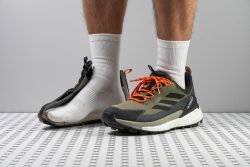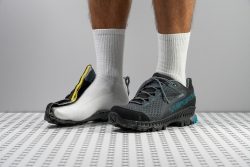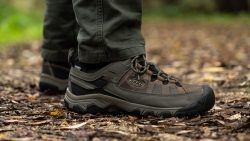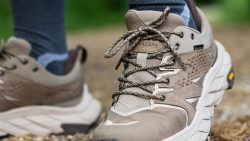4 Best Snow Hiking Shoes in 2025
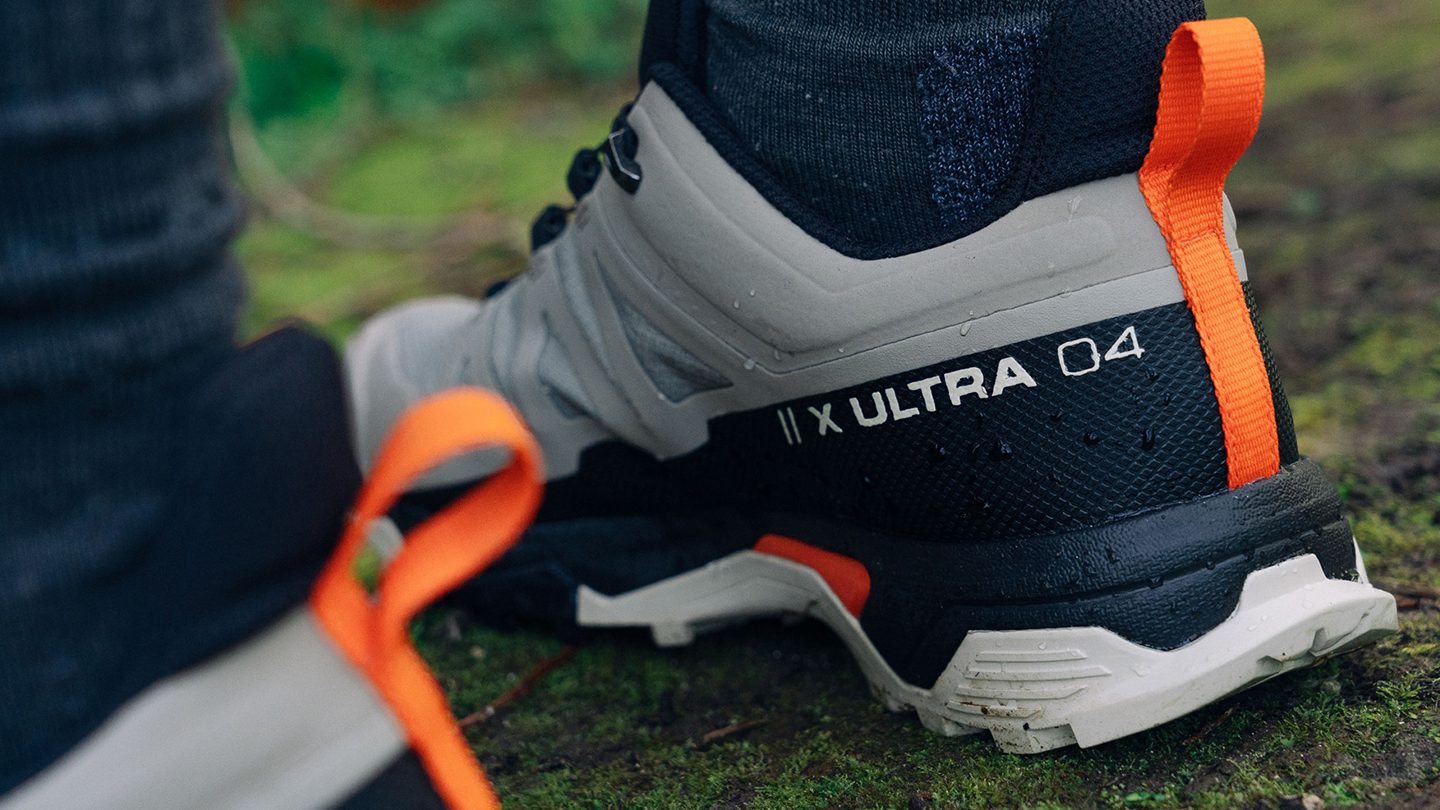
We buy shoes ourselves. We earn commissions when you buy through us, at no extra cost. Why trust us
Keep your feet warm on your next chilly adventure with the right pair of snow hiking shoes. After trudging through slush and snow in different pairs of shoes, we picked our chosen models that will keep you warm and protected all winter long.
The current offerings are superb when it comes to high-quality snow-specific designs, features, and overall performance. Your toes will remain comfy throughout the snowy adventure.
We’ve done the field testing and lab testing to rank our selections of the best snow hiking shoes available. To get you started right away, we have selected top picks for different categories.
How we test snow hiking shoes
For this guide, we’ve subjected each model to a battery of hiking tests. We’ve also brought all the shoes to our lab for additional standardised tests.
Our ranking process involves:
- Using our own money to purchase snow hiking shoes. This ensures 100% objectivity of our reviews.
- Hiking in each pair to gain first-hand experience of its fit, comfort, insulation, traction, and overall performance.
- Testing the shoes in the lab results in 20+ data points. We publish the data in our reviews and you can use it to compare different hiking shoes based on their breathability, durability, lug depth, traction, shock absorption, and other features. We also cut the shoes in half to see what's inside and perform more tests.
Best snow hiking shoes overall



































What makes it the best?
The Merrell Moab 3 GTX offers warmth and security in our trail sessions without making the shoe feel rigid or too harsh. We truly felt at home in its flexible midsole, while its protective upper and grippy Vibram outsole made us feel safe. Ultimately, it leads the snow hiking shoe roster in the lab.
A main feature that boosts comfort is its fluid design. In our bend test, it emerged 16.9% more malleable than average, making it suitable for long hours of walking and feeling comfortable straight out of the box.
We felt confident tackling slippery, snowy paths because the Vibram outsole delivers unmatched traction while its deep 4.8 mm lugs offer extra control with their strong bite.
The upper kept us warm in freezing temperatures, with its 1/5 breathability score in our smoke test proving it’s winterproof and waterproof. The Gore-Tex membrane effectively blocked water and sharp winds from entering the shoe.
However, this comfort-loaded shoe weighs a heavy 15.9 oz (452g), almost like a boot! Those who prioritise agility should look for other options.
Pros
- Superb day-one comfort
- Brilliant surface adhesion
- Supportive like a work shoe
- Remarkably durable
- A-grade waterproofing
- Sheds mud quite well
- Protective toe box
- Incredible overall quality
- Incredible overall quality
Cons
- Heavy for a low-top
- Subpar breathability
- Its shoelaces unravel often
- Minimal shock absorption
Snow hiking shoes with the best shock absorption
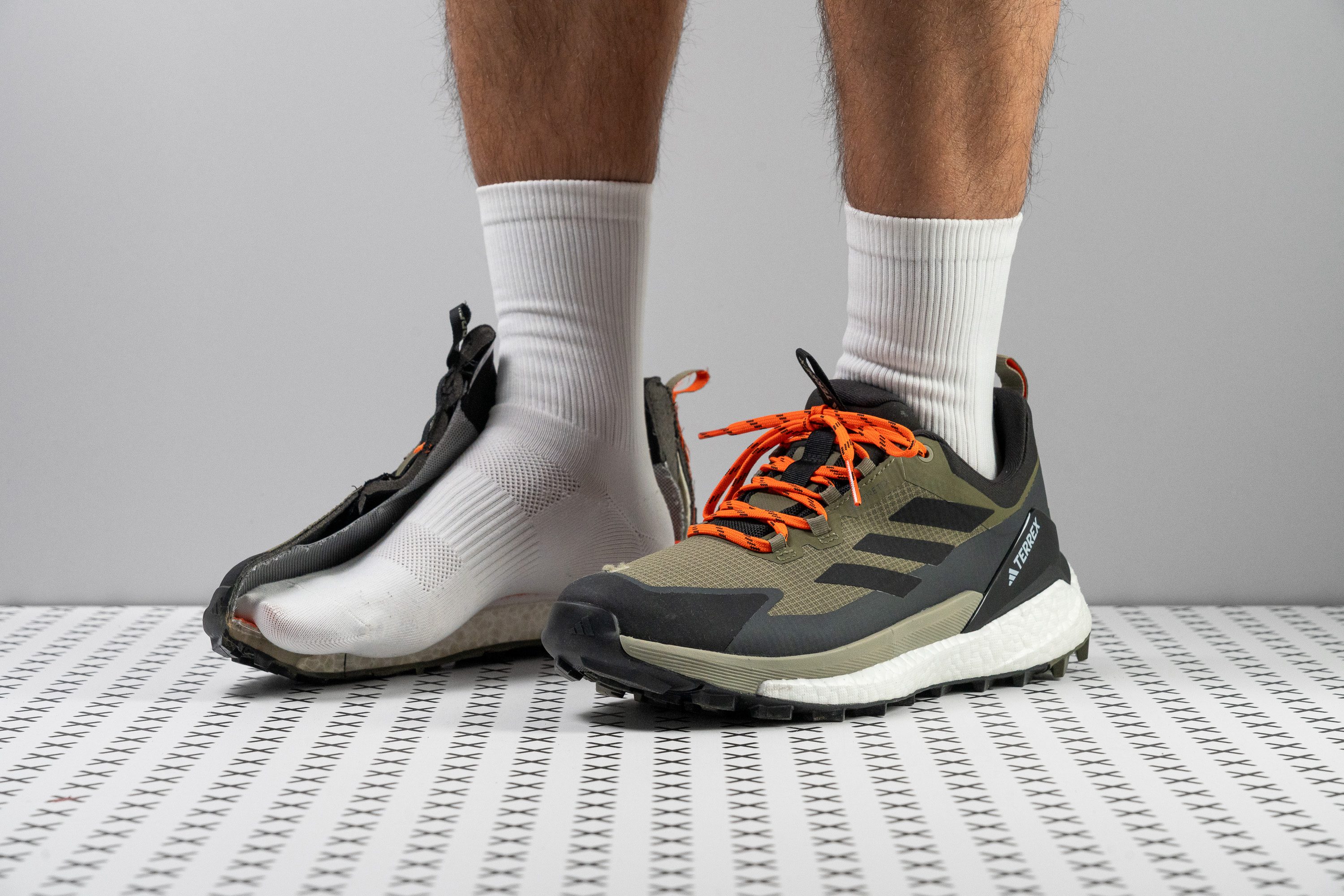



















































What makes it the best?
The cold never bothered us as long as we were in our trusty Adidas Terrex Free Hiker 2.0 Low GTX shoes. With a midsole so comfortable, a ride so stable, and an upper so warm, it’s our top shock-absorbing snow hiking shoe in the lab.
This Adidas shoe packs a lot of foam underfoot, and our calliper reveals it’s taller than the average at 37.2/24.6 mm. Even more noticeable on foot, the cushion itself offers 21.1% better shock absorption than average, proven by its solid 126 SA score. It conserves our legs and keeps them fresh for long hours on foot.
What makes the midsole so impressive is not only its comfort but also its stable ride. Amazingly, we never felt like toppling over because of the massive platform. True enough, our measurements show a wide 113.9/93.1 mm midsole. It also resists twisting firmly, showing a solid 4/5 torsional rigidity score in our test. Additionally, its aggressive 6.7 mm lugs in the heel and 3.6 mm lugs in other sections champion traction and control on icy paths.
The upper gave us the shield we needed against melted snow and painfully cold winds. Our feet felt at home inside the shoe, even in sub-zero temperatures. Our lab confirms its airtight nature with a 1/5 breathability score, perfect for waterproofing.
However, this heavy-duty shoe performs best in more challenging terrain. It will feel too harsh on easy and well-maintained trails.
Pros
- Well-cushioned and responsive
- A tonne of impact protection
- Rockered sole makes the ride smoother
- Barely gets firmer in low temperatures
- Excellent support and side-to-side stability
- Top-notch waterproofing
- Highly durable (especially the outsole)
- Ideal grip for technical terrain
- Sustainable materials (20%)
Cons
- Much heavier than average
- TPU heel clips may cause rubbing
Best lightweight snow hiking shoes
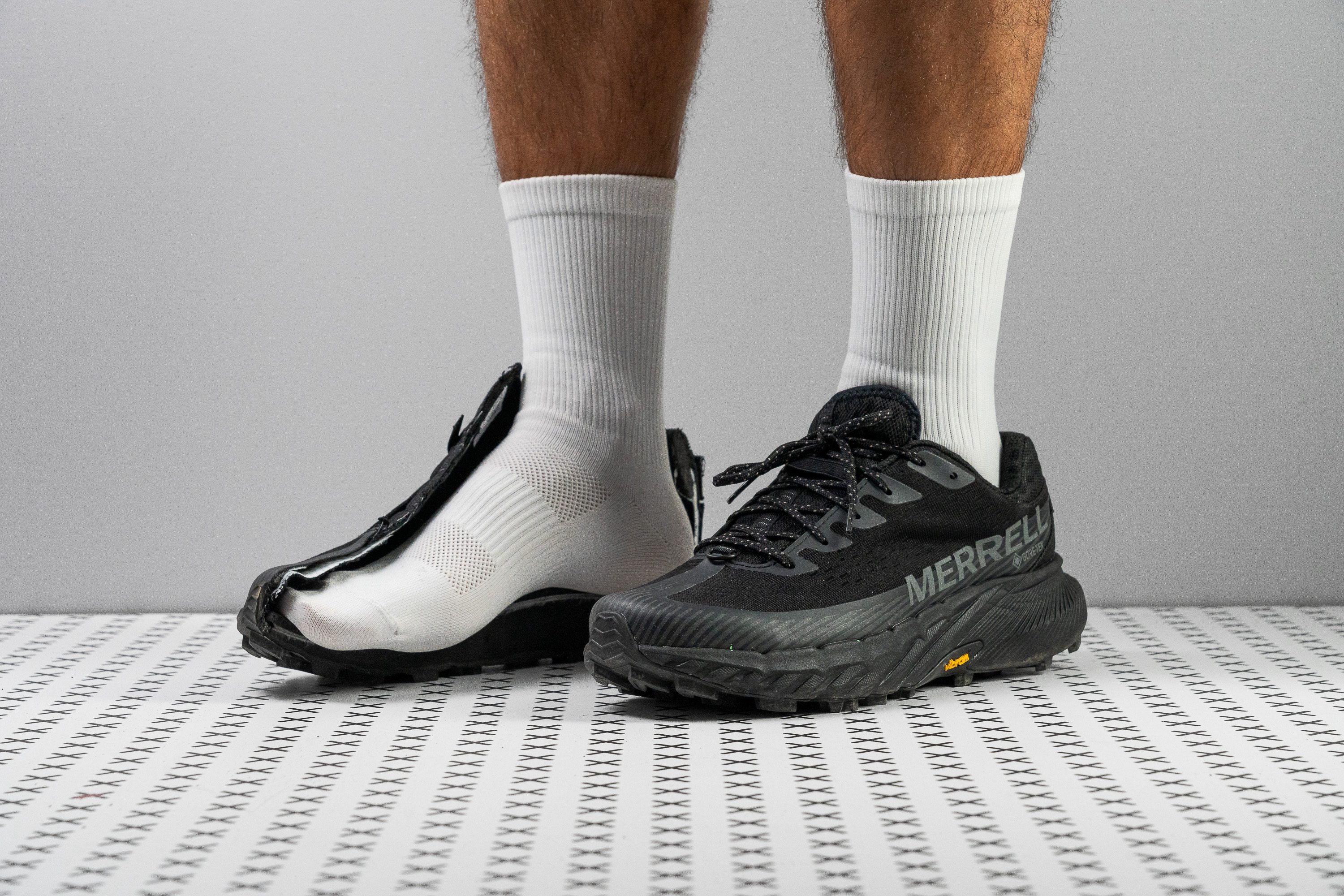













































What makes it the best?
Perfect for long hours of wear in cold weather, the Merrell Agility Peak 5 GTX kept us warm and comfortable by preventing cold, wet, or tired feet. Our lab tests validate it’s the best lightweight snow hiking shoe, enhancing a natural sensation together with the flexible midsole.
For all that it offers, we were pleased with its 10.4 oz (296g) figure. Its near-average weight offers above-average cushioning and protection. Its effortless sensation saves us from fatigue, further enhanced by the bendable midsole, which emerged 5.9% more pliable than average in our flex test.
Meanwhile, the upper shielded us from harsh winds and melted ice through its Gore-Tex membrane and dense construction. In our smoke test, this shoe scored the minimum 1/5 breathability rating, since neither air nor light could pass through.
The midsole feels divine underneath, supporting our multi-hour treks with lasting comfort. It feels impressively soft, and our durometer confirms it doesn’t toughen up in winter weather.
Unfortunately, it's best to keep this shoe on less abrasive surfaces. With its deep 1.4 mm damage in our Dremel test, it will wear out quickly on cement and asphalt pavements.
Pros
- True waterproof protection
- Grippy, trail-ready Vibram outsole
- Perfect for cold, wet climates
- Can handle some challenging conditions
- Stable yet cushioned heel
- Improved for hiking and walking
- Well-designed outsole lugs
- Great build quality
- Keeps feet warm
- Rock plate
Cons
- Narrow toebox
- Heel padding durability concerns
- No reflective elements
- Drop differs too much from stated
Snow hiking shoes with the best stability
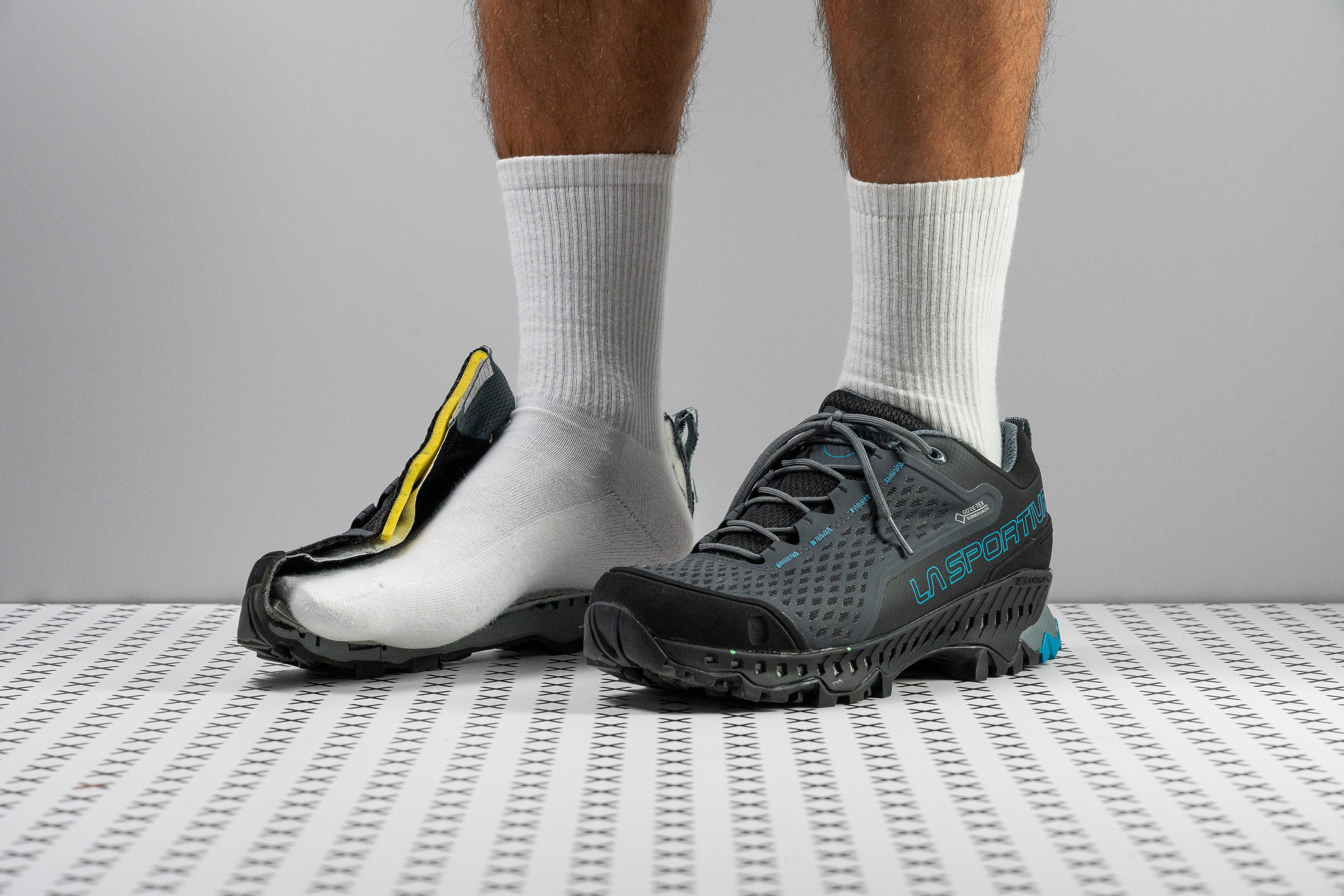





















































What makes it the best?
Whether we trekked through fresh snow or uneven terrain, we never lost our balance in the La Sportive Spire GTX. Diving deeper into the lab, we discovered the STB Control System at the core of its support. Further protection is brought by the grippy Vibram outsole and the airtight upper. Overall, we think it offers the best stability among snow hiking shoes.
The STB Control System features reinforced sidewalls that keep us centred. It generates solid twist resistance, proven by its high 4/5 torsional rigidity score in our manual assessment.
The Vibram outsole also keeps us in control of our footing, generating reliable traction, as proven by its 0.36 rating in our friction test. Moreover, its deep 4.3 mm lugs effectively latch onto various surfaces, such as fresh snow.
The upper consists of Gore-Tex membrane and synthetic overlays that effectively prevent sharp winter winds from entering. It retains our body heat, as seen in how smoke couldn’t escape in our breathability test (1/5).
However, this shoe’s boot-like protection made it 10.5% heavier than average. Hikers seeking an agile option should try lightweight alternatives.
Pros
- Feels like a backpacking boot with low collar
- Unparalleled stability and support
- Superb waterproofness with some breathabilty
- Mutes out rocks and debris like no other
- Excellent grip and braking
- Sturdy and durable construction
- Greater range of sizes allows to fine tune the fit
Cons
- Can feel tippy on rocky and hilly terrain
- Frail inner lining
- Gets even firmer in cold
3 things to prioritise in snow hiking shoes
Hiking in snow means you need protection from the cold weather and from the wet weather (snow). Based on all the tests we’ve done out on the trails and in our lab, here are our recommendations on what to look for in snow hiking shoes:
- Warmth. The colder the weather, the warmer the shoe should be. Some are even insulated so look for that. If not, look for the less breathable shoes. In our lab, we rate them with â or â , meaning they are not breezy and the warmth will stay inside.
- Waterproofness. Snow melts and you don’t want your hiking shoes to be completely soaked and to let the water inside. There are many waterproof membranes present on the market with Gore-Tex being the most popular one.
- Grip for snow. The hardness of the rubber, the depth of the lugs and the tread pattern all play a significant role when it comes to traction. For snow, we recommend deep lugs (deeper than 4 mm) and a pattern that does not allow for snow to get stuck.
We describe every one of these features below.
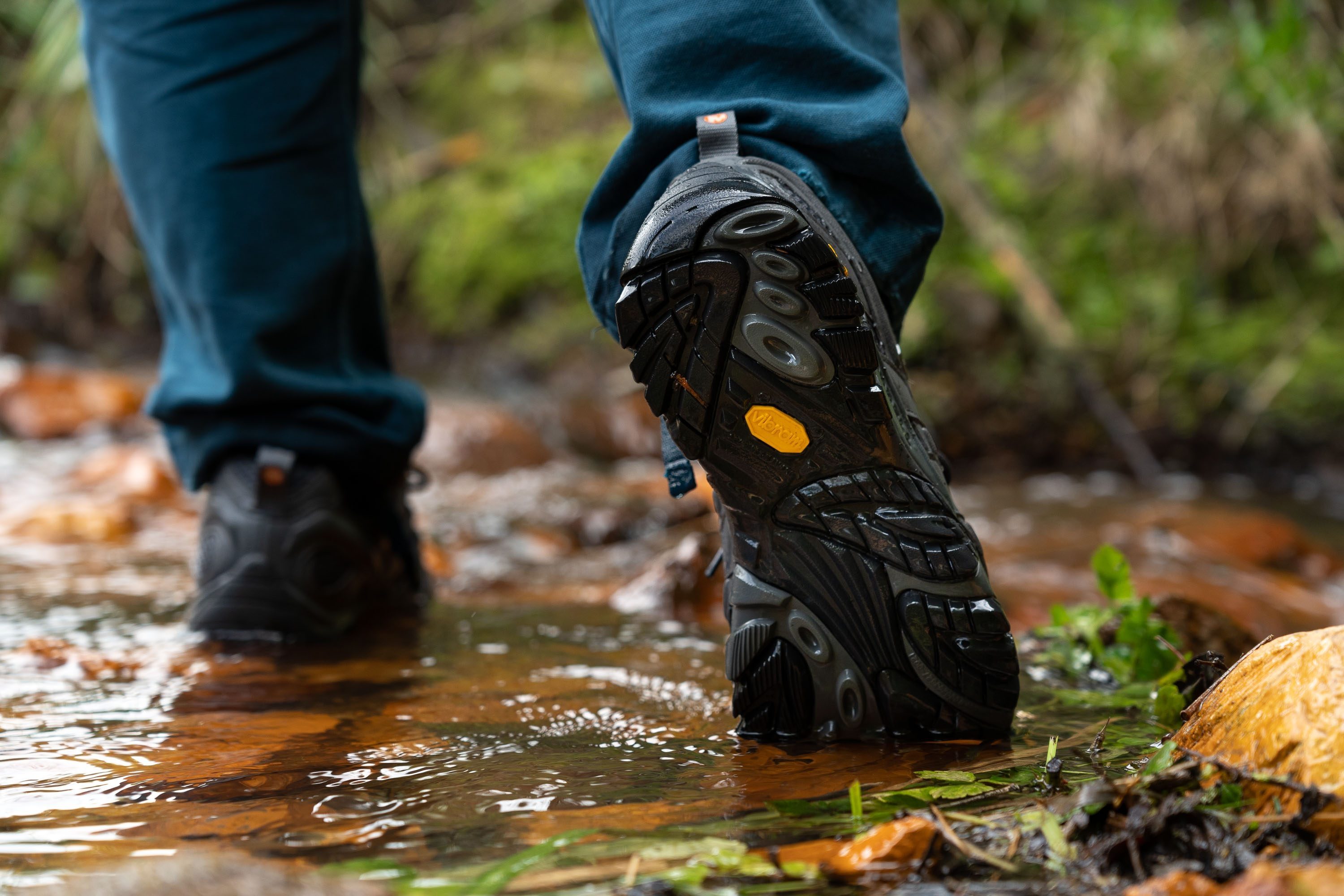
Why you should trust us? Not only do we test all the hiking shoes out on our test hikes, but we also tear them apart in the lab. This allows us to perform dozens of lab tests. One of them is freezing the shoes in our freezer. This allows us to simulate very cold weather conditions and then repeat some of the tests to anticipate how the shoes will behave in such weather.
However, if the snow is deep and you don’t like wearing gaiters (they also come with a GTX membrane, in case you did not know), consider getting snow hiking boots instead. With their mid or high cut, they are more likely to keep your feet warm and dry.
Look for warmth in your snow hiking shoes
Here, we suggest looking at the breathability of the shoe. Hiking shoes can be insulated, and insulation makes them even less breathable, and, therefore, warmer.
In our lab, we test for breathability by pumping the smoke inside the hiking shoe. We pay attention to where the smoke comes out and at which pace. This way, we’re able to rate the breathability of the shoe on a 1-5 scale, 1 being the least breathable.
Because snow hiking shoes also ask for waterproofness, this bad breathability rating is almost a given because waterproof hiking shoes never get flying colours for breathability.
We also check these uppers under the microscope and it's easy to see why non-waterproof materials breathe better. They don't only lack the lamination but are also looser in structure and might even have ventilation holes.

How to recognise waterproof materials
All waterproof hiking shoes have a waterproof membrane laminated to the upper material.

The shoe name itself can tell you whether the shoe is waterproof. It usually contains the words Waterproof, WP, or GTX for Gore-Tex. Other membranes are also available and that depends on what the brand has chosen to work with. Some brands develop their own waterproof membranes.
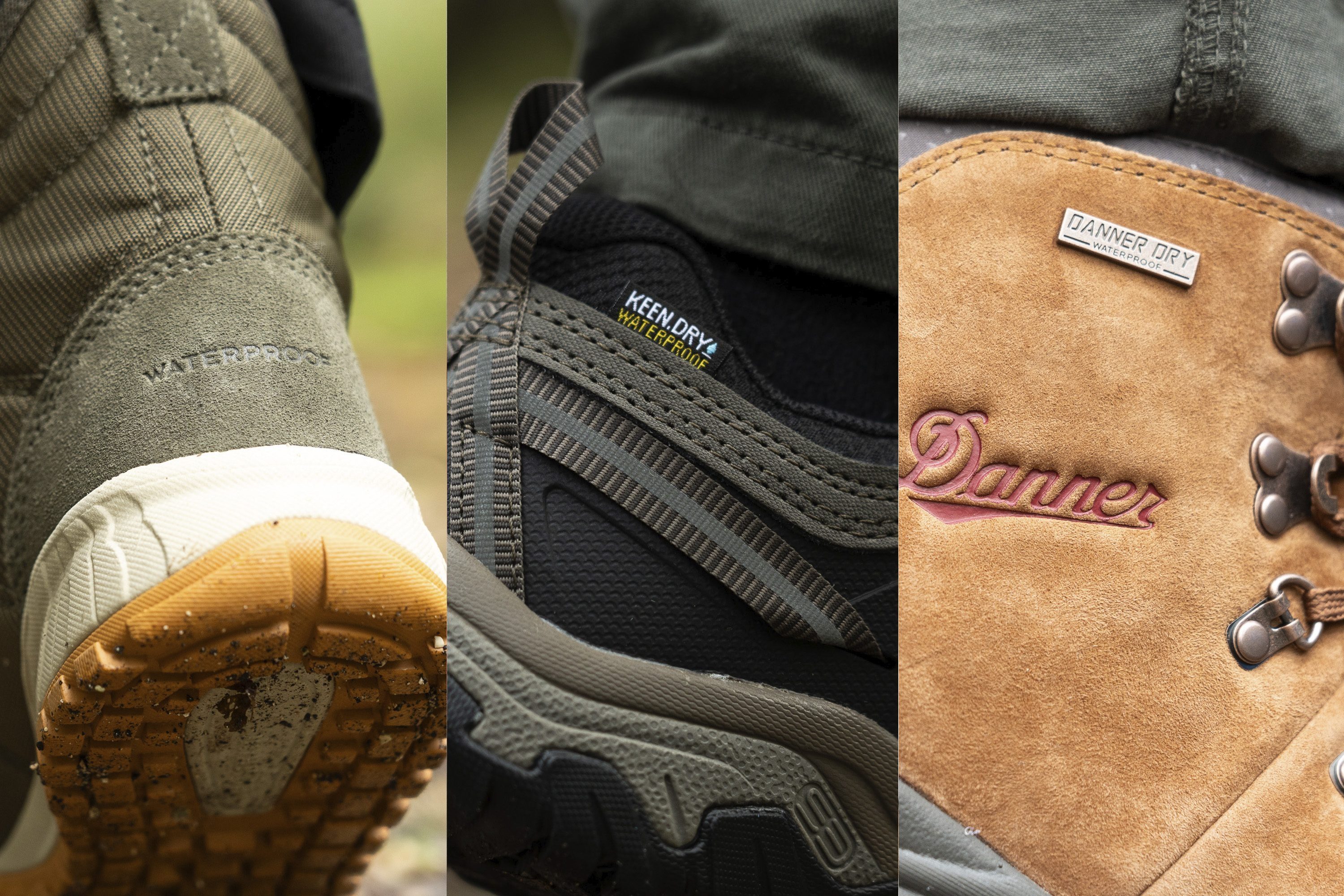
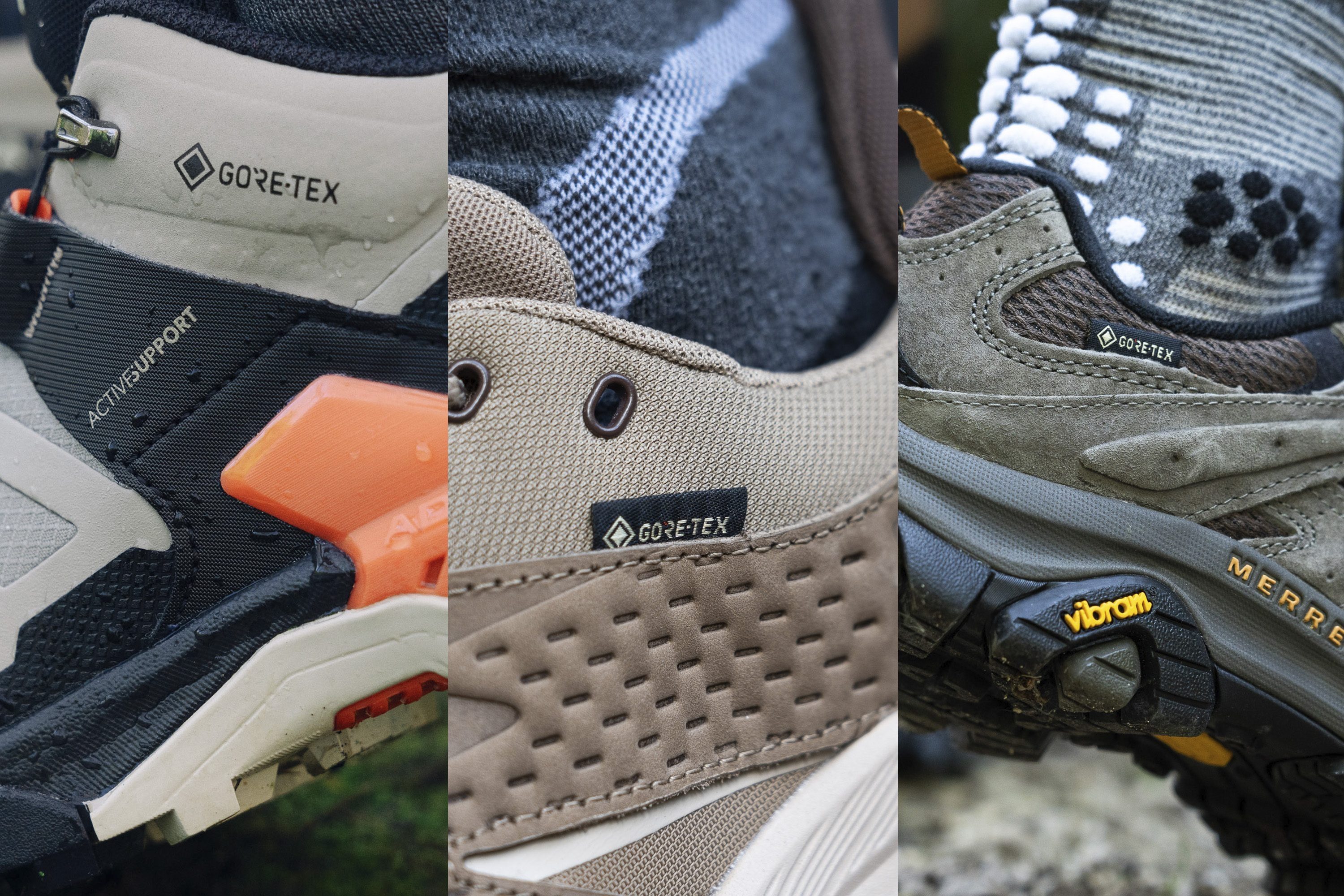
Gusseted tongue keeps the snow out
Having a waterproof upper is great because it can keep the snow out. But, when hiking in deeper snow, one that covers the eyelets, it is possible for the snow to sneak in. Having a gusseted tongue comes to the rescue.
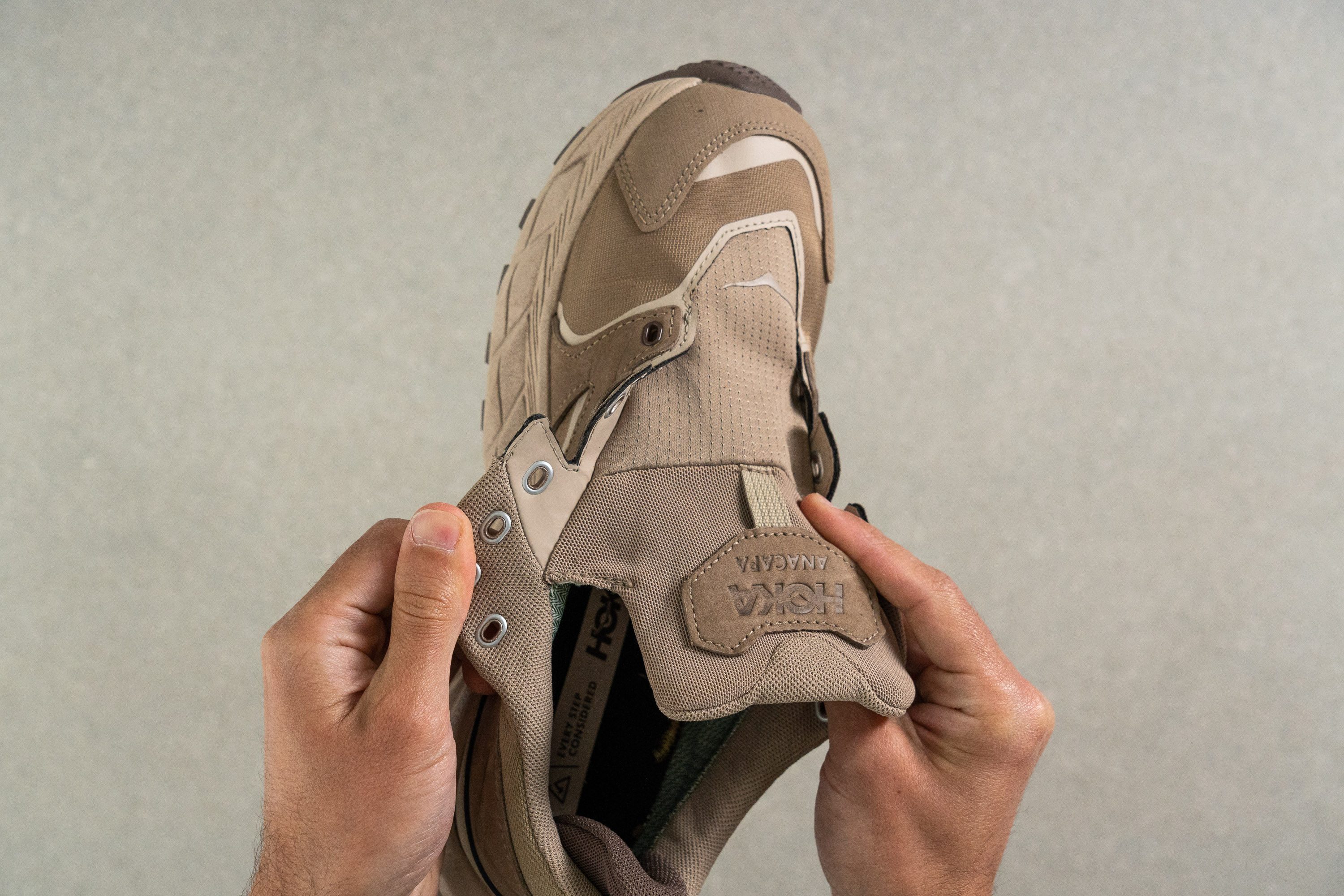
A gusseted tongue is a tongue that is attached to both sides of the shoe, just below the eyelets. Many hiking shoes have gusseted tongues, but it does not hurt to check this. In all of our reviews, we always take note of what kind of tongue gusset we found.
Here’s what different gussets look like in running shoes to get a clear picture.

Look for lugs that bite through the snow
In hiking, shallower lugs usually mean more versatility and nothing too demanding, while deeper lugs mean your shoes are ready to tackle challenging terrain. For snow, we advise getting hiking shoes with lugs that are at least 4 mm deep.
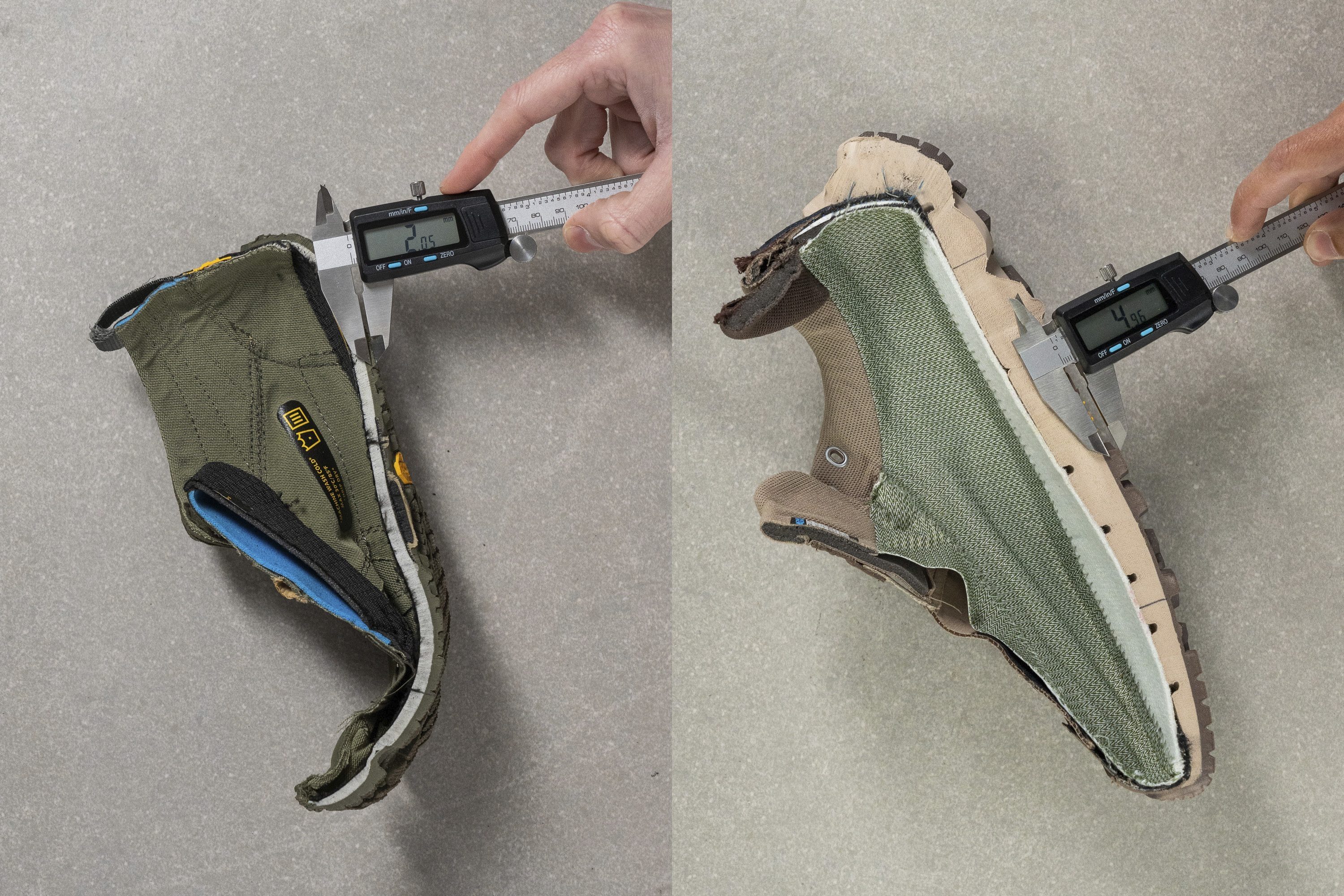
The hardness of the outsole also plays a role in traction. Softer rubber is usually stickier, while harder rubber is more durable and offers more protection.
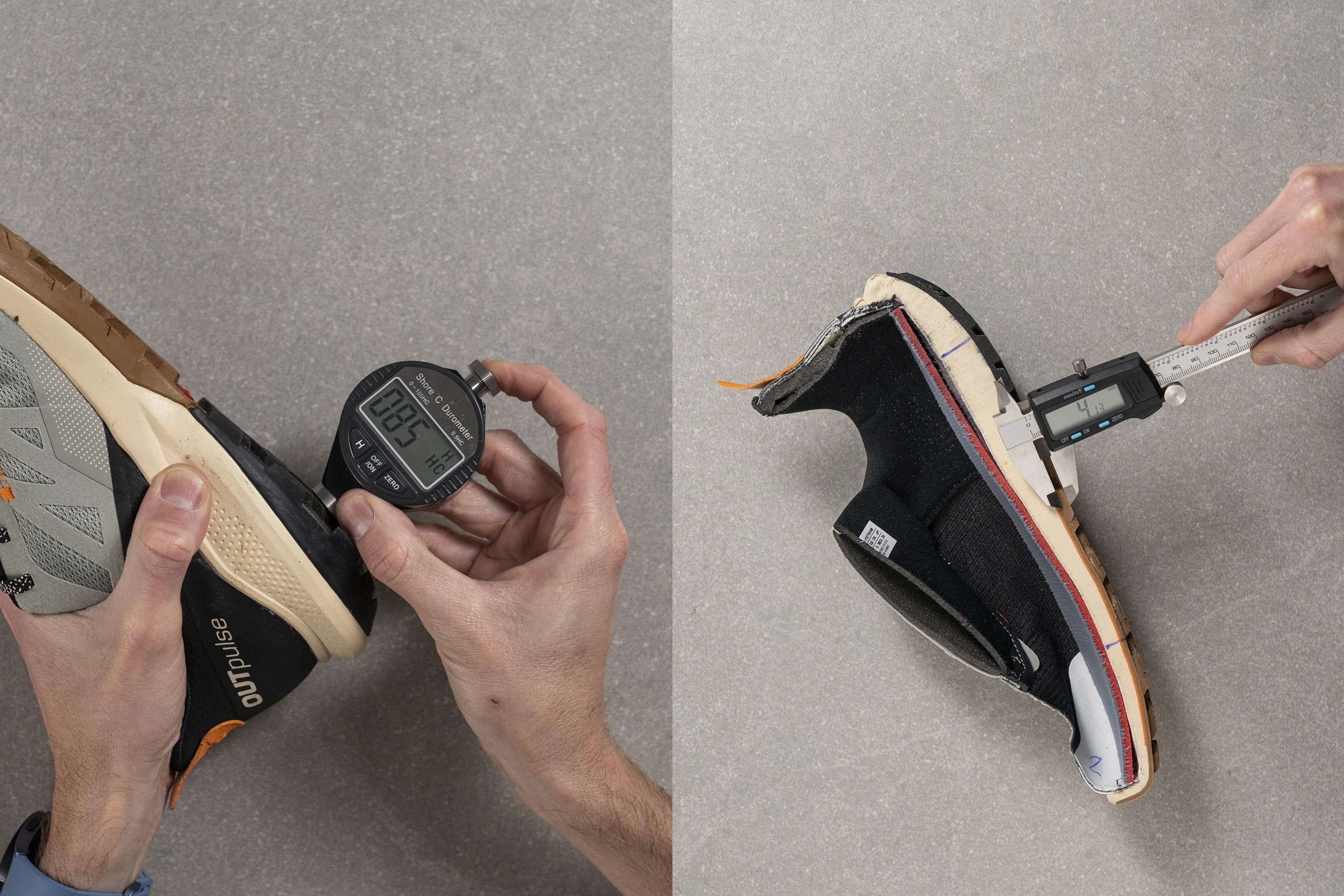
How durable are snow hiking shoes?
In our shoe lab, we do 3 durability tests. First, we press a dremel against the upper to see how durable the toebox is. This is very important in hiking shoes where toe bumpers are of great value - they keep our toes injury-free when encountering debris and all sorts of obstacles on the trails.
Based on the damage done by the dremel, we rate the durability on a 1-5 scale, where 5 is the most durable.
The second durability test we do follows the same methodology: press the dremel but, this time, on the inside of the heel counter, and rate it on a 1-5 scale, with 1 being the least durable.
Last but not least, we test the durability of the outsole. In this case, we’re able to precisely measure the dent made by the dremel, and we do it with a tyre tread depth gauge. The deeper the dent (more millimetres), the less durable the outsole is.
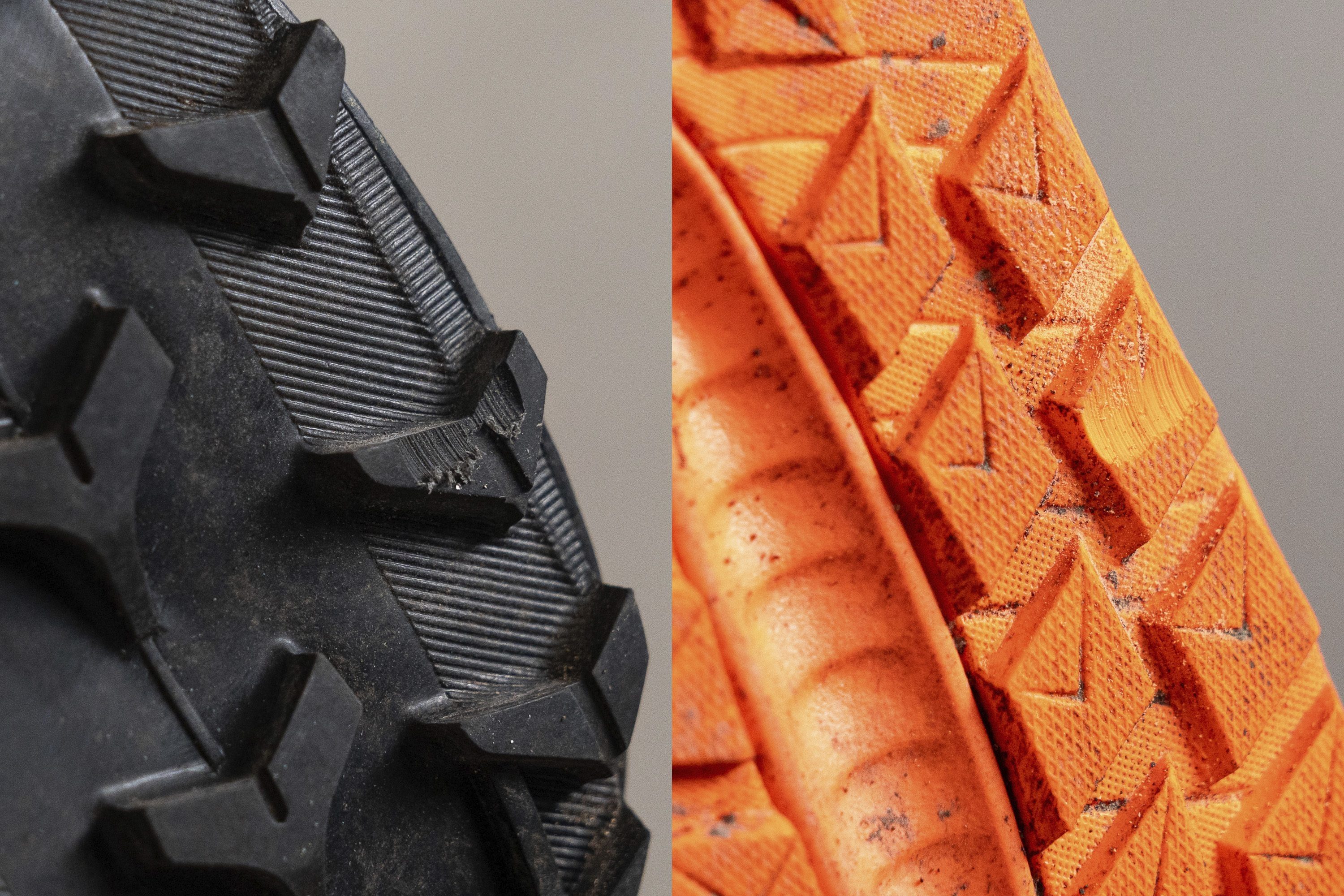
Shoes getting firmer and stiffer in cold weather is a no-go
Some shoes feel great at room temperature, they can be comfortable, maybe even soft. But, what if such midsole firms up 70% when it’s snowing? Would you still consider it for hiking in cold weather?

To anticipate how the hiking shoes feel in cold weather, we put them in a freezer.
Before and after the freezer, we check the softness of the midsole and the flexibility of the shoe.
The change in softness and flexibility tells us how the shoe will perform in cold weather. Because of this, we recommend getting shoes with the smallest change in those measurements because such shoes will feel more similar to how they feel at room temperature.
Socks and gaiters for snow hiking
To level up on the protection, we suggest using the gaiters, ideally the waterproof ones. They will prevent the snow from getting inside your hiking shoes, and they are usually easier to wash than the shoes, socks and pants together.

For very cold weather, merino wool socks have shown to be great. They wick away the moisture (if you happen to sweat), keep the feet warm, and don’t get stinky. There are thicker socks available for harsher weather conditions.
How to find a perfect fit in snow hiking shoes
If this is your first time buying hiking shoes, here are our guidelines on how to avoid common mistakes:
- Go hiking-shoe shopping in the afternoon or in the evening. Our feet are a bit swollen then, which is the same thing that happens on the hikes and best to try the shoes in such condition.
- Take the hiking socks and orthotics with you and use them in the shoes you’re trying out.
- Put the shoes on, lace them up, and try to sense the hotspots and pressure points. Hikers prefer having 1 thumb width at the front/back. It’s easier to test this by pushing the foot to the front of the shoe and then sticking a thumb behind your heel inside the shoe.
- Test the shoes on the ramp, go up and down. Look for a comfortable lockdown. There should be no heel slipping or sliding to the sides.
Keep in mind that some hiking shoes need to be broken in. Don’t go on a long hike immediately.
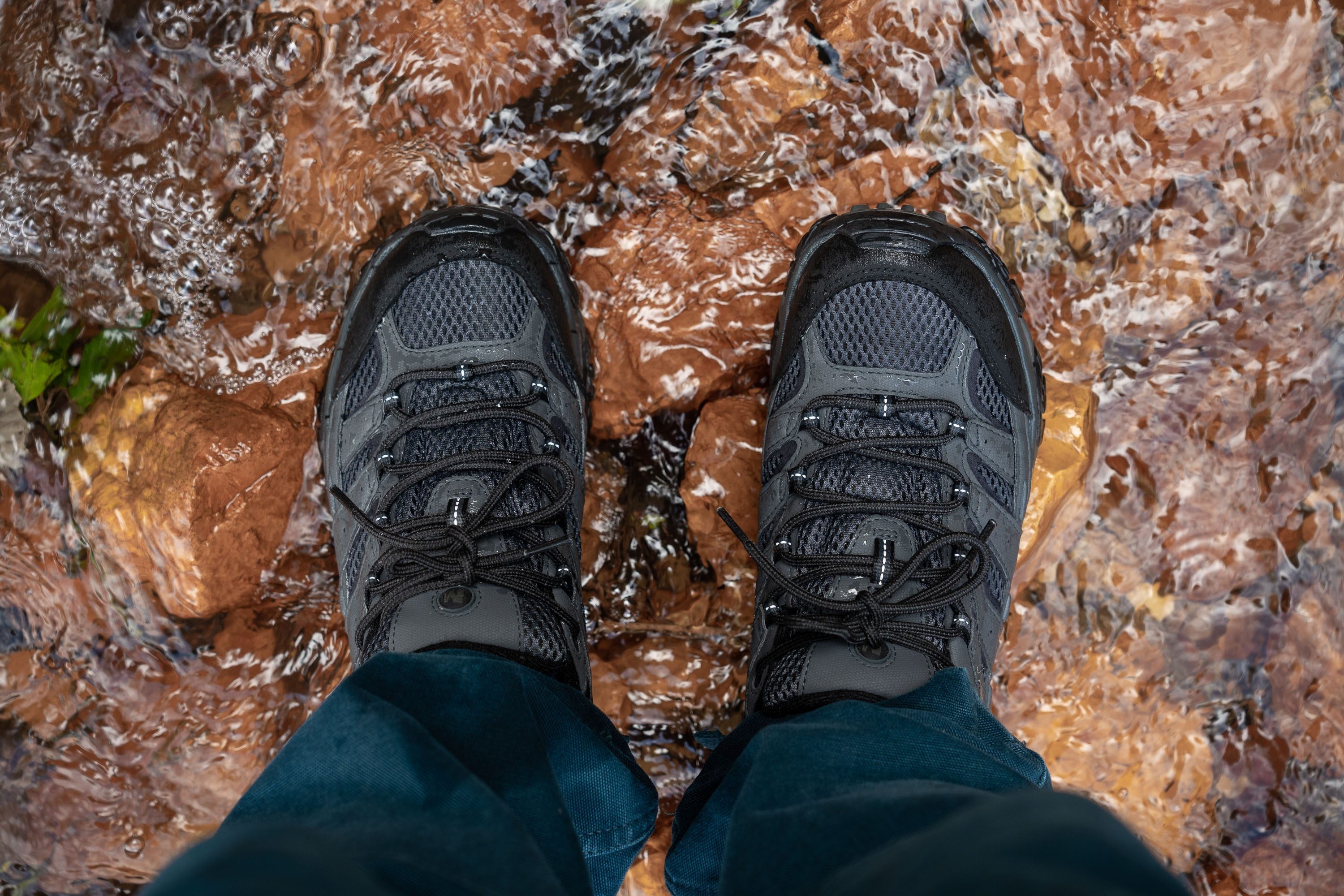
Understanding insulation in snow hiking footwear
Insulation sets snow hiking shoes apart from regular hiking shoes. Therefore, insulation is one of the most important components of snow hiking shoes. Ironically, insulation in hiking shoes can be somewhat convoluted to understand.
Shoe insulation specs do not refer to the total weight of insulation inside the shoe. Instead, insulation ratings refer to the thickness of the insulation used inside the shoe.
Let us explain more. A shoe with an advertised 600g of insulation does not weigh an additional 600 grammes because of the insulation on the inside. That would be a lot!
Instead, the 600g insulation rating tells you that the insulation weighs 600 grammes per square metre. Grammes per square metre is the standardised unit of measurement for hiking shoe insulation.
|
Weight (Grammes/ Square Metre) |
Recommended Temperature Range |
Season |
Recommended Uses |
|
100 grammes |
40 to 50 degrees F |
3- season |
|
|
200 grammes |
30 to 40 degrees F |
3-season |
|
|
400 grammes |
14 to 30 degrees F |
3-season |
|
|
600 grammes |
-5 to 10 degrees F |
Winter |
|
|
800 grammes |
-20 to -10 degrees F |
Winter |
|


